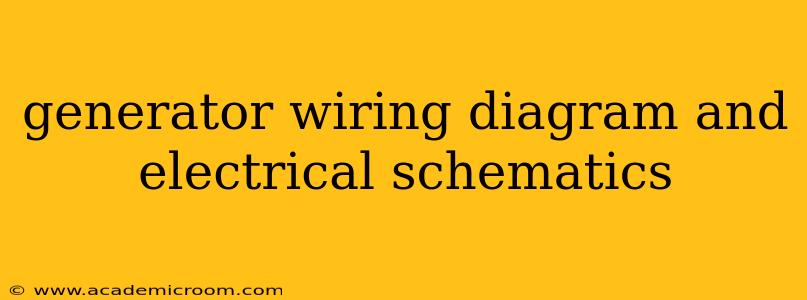Understanding the electrical schematics and wiring diagrams of a generator is crucial for safe and efficient operation. This guide will delve into the intricacies of generator wiring, explaining different components, common configurations, and troubleshooting tips. Whether you're a seasoned electrician or a homeowner looking to maintain your generator, this information will be invaluable.
What is a Generator Wiring Diagram?
A generator wiring diagram is a visual representation of the electrical connections within a generator. It shows how various components, such as the engine, alternator, voltage regulator, and circuit breaker, are interconnected. These diagrams are essential for installation, maintenance, and troubleshooting. They use standardized symbols to represent different electrical components, making them easily understandable by technicians and professionals.
Types of Generator Wiring Diagrams
Generator wiring diagrams vary depending on the generator's size, type, and features. Common types include:
- Simplified Diagrams: These diagrams show the main components and their connections in a simplified manner, omitting less crucial details. They are helpful for a basic understanding of the generator's electrical system.
- Detailed Diagrams: These diagrams offer a comprehensive overview, including every wire, connection, and component. They are invaluable for troubleshooting complex issues or for detailed maintenance.
- Schematic Diagrams: These diagrams use standardized symbols to represent electrical components and their interconnections. They are useful for understanding the electrical flow and identifying potential problems.
Key Components Shown in a Generator Wiring Diagram
Several key components are consistently featured in generator wiring diagrams. Understanding their function is paramount:
- Alternator: This component generates AC power. The wiring diagram shows its connections to the voltage regulator and the main output terminals.
- Voltage Regulator: This crucial component regulates the output voltage of the alternator, ensuring stable power supply.
- Engine Control Module (ECM): In more advanced generators, an ECM controls various aspects of engine operation, including starting and shutdown. The wiring diagram will illustrate its connections.
- Circuit Breakers: These safety devices protect the generator and connected loads from overcurrent. The diagram will show how they are integrated into the circuit.
- Output Terminals: These are the connection points where the generator's power output is accessible. The diagram will clearly illustrate these terminals and their voltage ratings.
- Grounding: Proper grounding is essential for safety. The wiring diagram will demonstrate the grounding connections, ensuring electrical safety.
Understanding Electrical Schematics
Electrical schematics provide a more abstract representation of the generator's electrical system. Unlike wiring diagrams, which show physical wire routing, schematics focus on the functional relationships between components. They use symbols to represent components and lines to represent connections, simplifying complex systems into an easier-to-understand format.
How to Read a Generator Wiring Diagram
Reading a generator wiring diagram requires understanding the symbols used. Most diagrams will include a legend explaining these symbols. Generally, lines represent wires, and different colored lines may indicate different voltage levels or circuits. Following the lines will reveal the connection path between components.
H2: What are the common problems found in generator wiring?
Common problems include loose connections, damaged wires, faulty voltage regulators, and tripped circuit breakers. Regular inspection and preventative maintenance can minimize these issues.
H2: How do I troubleshoot a generator wiring problem?
Systematic troubleshooting is key. Start by visually inspecting all wires and connections for damage or looseness. Check circuit breakers and the voltage regulator for faults. Using a multimeter to test voltage and continuity can help identify specific problems. Always disconnect the generator from the power source before performing any maintenance or troubleshooting.
H2: Can I create my own generator wiring diagram?
Creating your own wiring diagram is possible but requires a deep understanding of electrical systems and safety procedures. It's generally recommended to rely on the manufacturer's diagram or consult a qualified electrician for any wiring modifications or repairs.
This comprehensive guide provides a foundational understanding of generator wiring diagrams and electrical schematics. Remember, safety is paramount when working with electricity. If you're unsure about any aspect of your generator's electrical system, always consult a qualified electrician. Proper understanding of these diagrams will enable you to perform maintenance, troubleshoot problems, and ensure the safe and efficient operation of your generator.
